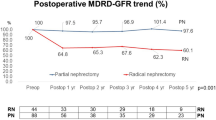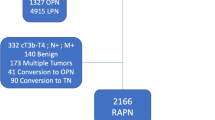Abstract
Wilms tumor is the most common renal malignancy in children. In the 1930s, overall survival for children with Wilms tumor was approximately 30%. Use of multidisciplinary therapy, guided by results from multi-institutional, randomized trials, has substantially improved overall survival to about 90%. Management of Wilms tumor differs substantially between Europe and the US. In Europe, the International Society of Pediatric Oncology protocols call for management of patients with presumptive Wilms tumor with neoadjuvant chemotherapy followed by nephrectomy and further chemotherapy. In the US, protocols developed by the National Wilms Tumor Study Group advise primary nephrectomy followed by a chemotherapy regimen tailored to the pathologic tumor stage. Despite these disparate strategies, overall survival is similar in patients managed according to European and US protocols. Patients with Wilms tumor now have excellent survival. Therefore, current goals aim to reduce the morbidity associated with therapy. Important complications of treatment for Wilms tumor include cardiomyopathy, renal failure, and increased risk of a secondary malignancy. Currently, the role of laparoscopic surgery in management of Wilms tumor remains extremely limited.
Key Points
-
Multidisciplinary therapy has improved overall survival for patients with Wilms tumor to approximately 90%
-
In North America, National Wilms Tumor Study Group protocols dictate primary nephrectomy followed by chemotherapy for most patients who have Wilms tumor
-
In Europe, International Society of Pediatric Oncology protocols call for neoadjuvant chemotherapy in cases of presumptive Wilms tumor; this initial treatment is followed by nephrectomy and further chemotherapy
-
Despite their different strategies, overall survival rates achieved by NWTSG and SIOP approaches are similar
-
Prognostic factors in patients with Wilms tumor include disease stage, histology, patient age, and biological markers; the most powerful prognostic indicator is tumor histology
This is a preview of subscription content, access via your institution
Access options
Subscribe to this journal
Receive 12 print issues and online access
$209.00 per year
only $17.42 per issue
Buy this article
- Purchase on Springer Link
- Instant access to full article PDF
Prices may be subject to local taxes which are calculated during checkout
Similar content being viewed by others
References
Gurney JG et al. (1995) Incidence of cancer in children in the United States. Sex-, race-, and 1-year age-specific rates by histologic type. Cancer 75: 2186–2195
Grovas A et al. (1997) The National Cancer Data Base report on patterns of childhood cancers in the United States. Cancer 80: 2321–2332
Metzger ML and Dome JS (2005) Current therapy for Wilms' tumor. Oncologist 10: 815–826
Tournade MF et al. (2001) Optimal duration of preoperative therapy in unilateral and nonmetastatic Wilms' tumor in children older than 6 months: results of the Ninth International Society of Pediatric Oncology Wilms' Tumor Trial and Study. J Clin Oncol 19: 488–500
Madre C et al. (2006) Hypertension in childhood cancer: a frequent complication of certain tumor sites. J Pediatr Hematol Oncol 28: 659–664
Sukarochana K et al. (1972) Wilms' tumor and hypertension. J Pediatr Surg 7: 573–576
Brisse HJ et al. (2008) Preoperative Wilms tumor rupture: a retrospective study of 57 patients. Cancer 113: 202–213
Nicolin G et al. (2008) Outcome after pulmonary radiotherapy in Wilms' tumor patients with pulmonary metastases at diagnosis: a UK Children's Cancer Study Group, Wilms' Tumour Working Group Study. Int J Radiat Oncol Biol Phys 70: 175–180
Bonadio JF et al. (1985) Anaplastic Wilms' tumor: clinical and pathologic studies. J Clin Oncol 3: 513–520
Breslow N et al. (1985) Prognosis for Wilms' tumor patients with nonmetastatic disease at diagnosis—results of the second National Wilms' Tumor Study. J Clin Oncol 3: 521–531
Faria P et al. (1996) Focal versus diffuse anaplasia in Wilms tumor—new definitions with prognostic significance: a report from the National Wilms Tumor Study Group. Am J Surg Pathol 20: 909–920
Dome JS et al. (2006) Treatment of anaplastic histology Wilms' tumor: results from the fifth National Wilms' Tumor Study. J Clin Oncol 24: 2352–2358
Vujanic GM et al. (2002) Revised International Society of Paediatric Oncology (SIOP) working classification of renal tumors of childhood. Med Pediatr Oncol 38: 79–82
de Kraker J et al. (2004) Reduction of postoperative chemotherapy in children with stage I intermediate-risk and anaplastic Wilms' tumour (SIOP 93-01 trial): a randomised controlled trial. Lancet 364: 1229–1235
Breslow N et al. (1991) Prognostic factors in nonmetastatic, favorable histology Wilms' tumor. Results of the Third National Wilms' Tumor Study. Cancer 68: 2345–2353
van den Heuvel-Eibrink MM et al. (2008) Characteristics and survival of 750 children diagnosed with a renal tumor in the first seven months of life: a collaborative study by the SIOP/GPOH/SFOP, NWTSG, and UKCCSG Wilms tumor study groups. Pediatr Blood Cancer 50: 1130–1134
Grundy PE et al. (1994) Loss of heterozygosity for chromosomes 16q and 1p in Wilms' tumors predicts an adverse outcome. Cancer Res 54: 2331–2333
Grundy PE et al. (2005) Loss of heterozygosity for chromosomes 1p and 16q is an adverse prognostic factor in favorable-histology Wilms tumor: a report from the National Wilms Tumor Study Group. J Clin Oncol 23: 7312–7321
D'Angio GJ et al. (1976) The treatment of Wilms' tumor: results of the National Wilms' Tumor Study. Cancer 38: 633–646
D'Angio GJ et al. (1981) The treatment of Wilms' tumor: results of the second National Wilms' Tumor Study. Cancer 47: 2302–2311
D'Angio GJ et al. (1989) Treatment of Wilms' tumor. Results of the third National Wilms' Tumor Study. Cancer 64: 349–360
Green DM et al. (1998) Comparison between single-dose and divided-dose administration of dactinomycin and doxorubicin for patients with Wilms' tumor: a report from the National Wilms' Tumor Study Group. J Clin Oncol 16: 237–245
Shamberger RC et al. (1999) Surgery-related factors and local recurrence of Wilms tumor in National Wilms Tumor Study 4. Ann Surg 229: 292–297
Green DM et al. (2001) Treatment with nephrectomy only for small, stage I/favorable histology Wilms' tumor: a report from the National Wilms' Tumor Study Group. J Clin Oncol 19: 3719–3724
Shamberger RC (1999) Pediatric renal tumors. Semin Surg Oncol 16: 105–120
Graf N et al. (2000) The role of preoperative chemotherapy in the management of Wilms' tumor. The SIOP studies. International Society of Pediatric Oncology. Urol Clin North Am 27: 443–454
Tournade MF et al. (1993) Results of the Sixth International Society of Pediatric Oncology Wilms' Tumor Trial and Study: a risk-adapted therapeutic approach in Wilms' tumor. J Clin Oncol 11: 1014–1023
Lemerle J et al. (1976) Preoperative versus postoperative radiotherapy, single versus multiple courses of actinomycin D, in the treatment of Wilms' tumor. Preliminary results of a controlled clinical trial conducted by the International Society of Paediatric Oncology (SIOP). Cancer 38: 647–654
Lemerle J et al. (1983) Effectiveness of preoperative chemotherapy in Wilms' tumor: results of an International Society of Paediatric Oncology (SIOP) clinical trial. J Clin Oncol 1: 604–609
Lee IS et al. (1995) Needle tract seeding after percutaneous biopsy of Wilms tumor. J Urol 153: 1074–1076
Mitchell C et al. (2006) Immediate nephrectomy versus preoperative chemotherapy in the management of non-metastatic Wilms' tumour: results of a randomised trial (UKW3) by the UK Children's Cancer Study Group. Eur J Cancer 42: 2554–2562
Hall G et al. (2006) Predictors of surgical outcome in Wilms' tumor: a single-institution comparative experience. J Pediatr Surg 41: 966–971
Kumar R et al. (1998) Conservative surgical management of bilateral Wilms tumor: results of the United Kingdom Children's Cancer Study Group. J Urol 160: 1450–1453
Coppes MJ et al. (1989) Bilateral Wilms' tumor: long-term survival and some epidemiological features. J Clin Oncol 7: 310–315
Blute ML et al. (1987) Bilateral Wilms tumor. J Urol 138: 968–973
Ritchey ML and Coppes MJ (1995) The management of synchronous bilateral Wilms tumor. Hematol Oncol Clin North Am 9: 1303–1315
Horwitz JR et al. (1996) Renal salvage procedures in patients with synchronous bilateral Wilms' tumors: a report from the National Wilms' Tumor Study Group. J Pediatr Surg 31: 1020–1025
Davidoff AM et al. (2008) The feasibility and outcome of nephron-sparing surgery for children with bilateral Wilms tumor. The St Jude Children's Research Hospital experience: 1999–2006. Cancer 112: 2060–2070
Dome JS et al. (2002) Improved survival for patients with recurrent Wilms tumor: the experience at St Jude Children's Research Hospital. J Pediatr Hematol Oncol 24: 192–198
Kalapurakal JA et al. (2004) Management of Wilms' tumour: current practice and future goals. Lancet Oncol 5: 37–46
Kremens B et al. (2002) High-dose chemotherapy with autologous stem cell rescue in children with nephroblastoma. Bone Marrow Transplant 30: 893–898
Campbell AD et al. (2004) Treatment of relapsed Wilms' tumor with high-dose therapy and autologous hematopoietic stem-cell rescue: the experience at Children's Memorial Hospital. J Clin Oncol 22: 2885–2890
Haddy TB et al. (2007) Hypertension and prehypertension in long-term survivors of childhood and adolescent cancer. Pediatr Blood Cancer 49: 79–83
Baudoin P et al. (1993) Renal function up to 50 years after unilateral nephrectomy in childhood. Am J Kidney Dis 21: 603–611
Huang WC et al. (2006) Chronic kidney disease after nephrectomy in patients with renal cortical tumours: a retrospective cohort study. Lancet Oncol 7: 735–740
Wilimas JA et al. (1991) The potential for renal salvage in nonmetastatic unilateral Wilms' tumor. Am J Pediatr Hematol Oncol 13: 342–344
Moorman-Voestermans CG et al. (1998) Is partial nephrectomy appropriate treatment for unilateral Wilms' tumor? J Pediatr Surg 33: 165–170
Ritchey ML et al. (1996) Renal failure in Wilms' tumor patients: a report from the National Wilms' Tumor Study Group. Med Pediatr Oncol 26: 75–80
Haecker FM et al. (2003) Partial nephrectomy for unilateral Wilms tumor: results of study SIOP 93-01/GPOH. J Urol 170: 939–942
Cozzi F et al. (2004) Re: partial nephrectomy for unilateral Wilms tumor: results of study SIOP 93-01/GPOH. J Urol 171: 2383
Green DM et al. (1993) Treatment outcomes in patients less than 2 years of age with small, stage I, favorable-histology Wilms' tumors: a report from the National Wilms' Tumor Study. J Clin Oncol 11: 91–95
Breslow NE et al. (2004) Doxorubicin for favorable histology, stage II–III Wilms tumor: results from the National Wilms Tumor Studies. Cancer 101: 1072–1080
Green DM et al. (2001) Congestive heart failure after treatment for Wilms' tumor: a report from the National Wilms' Tumor Study Group. J Clin Oncol 19: 1926–1934
Green DM et al. (2002) Pregnancy outcome after treatment for Wilms tumor: a report from the National Wilms Tumor Study Group. J Clin Oncol 20: 2506–2513
Taylor AJ et al. (2008) Second primary neoplasms in survivors of Wilms' tumour—a population-based cohort study from the British Childhood Cancer Survivor Study. Int J Cancer 122: 2085–2093
Duarte RJ et al. (2004) Laparoscopic nephrectomy for Wilms tumor after chemotherapy: initial experience. J Urol 172: 1438–1440
Duarte RJ et al. (2006) Further experience with laparoscopic nephrectomy for Wilms' tumour after chemotherapy. BJU Int 98: 155–159
Beckwith JB (1993) Precursor lesions of Wilms tumor: clinical and biological implications. Med Pediatr Oncol 21: 158–168
Coppes MJ et al. (1999) Factors affecting the risk of contralateral Wilms tumor development: a report from the National Wilms Tumor Study Group. Cancer 85: 1616–1625
Uba AF and Chirdan LB (2007) Childhood Wilms' tumour: prognostic factors in North Central Nigeria. West Afr J Med 26: 222–225
Author information
Authors and Affiliations
Corresponding author
Ethics declarations
Competing interests
The authors declare no competing financial interests.
Rights and permissions
About this article
Cite this article
Sonn, G., Shortliffe, L. Management of Wilms tumor: current standard of care. Nat Rev Urol 5, 551–560 (2008). https://doi.org/10.1038/ncpuro1218
Received:
Accepted:
Issue Date:
DOI: https://doi.org/10.1038/ncpuro1218
This article is cited by
-
METTL14 gene polymorphisms decrease Wilms tumor susceptibility in Chinese children
BMC Cancer (2021)
-
Is it time to make minimally invasive surgery in pediatric oncology inclusive?
Journal of Pediatric Endoscopic Surgery (2021)
-
Non-coding RNAs in Wilms’ tumor: biological function, mechanism, and clinical implications
Journal of Molecular Medicine (2021)
-
MiR-200a with CDC7 as a direct target declines cell viability and promotes cell apoptosis in Wilm’s tumor via Wnt/β-catenin signaling pathway
Molecular and Cellular Biochemistry (2021)
-
Retinoic acid pathway activity in wilms tumors and characterization of biological responses in vitro
Molecular Cancer (2011)



